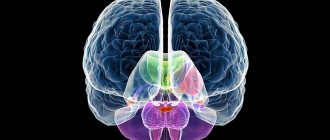Memory impairments are very diverse and do not always arise as a result of internal factors (poor vascular conductivity, neuralgia). Simple overwork can provoke some kind of disorder. The most common memory loss is hypomnesia.
At the same time, the patient perfectly remembers all the important dates in his life, the names of relatives and friends. Problems arise with reproducing detailed information about the events of previous days.
In some cases, the condition may be accompanied by anekphoria, when a person cannot remember basic words, or even names, without prompting from another person. This feature may sometimes be observed when patients better assimilate visual information and poorly remember information by ear. It also happens the other way around.
The progress of violations should be monitored with special attention and responsibility. Disease progression is often observed. The result can be a complete disruption of all types and processes of memorization - amnesia.
The table shows the characteristics of memory impairment
With brain injuries, retrograde amnesia can occur, which is characterized by memory loss associated with the moment it was received. In this case, the patient can clearly remember the events that happened before the injury.
Anterograde amnesia can occur when there is a period of time immediately after the injury.
Clinical picture
Memory is a cognitive process associated with preserving, remembering and reproducing a person’s past experiences.
There are several types of memory: motor, emotional, figurative, verbal-logical, involuntary, semantic. Based on the duration of information storage, short-term, long-term and operational memory are distinguished.
The processes include: memorization, imprinting, reproduction, recognition, recollection, preservation. The joint activity of these main components guarantees its successful development. If a particular species or process begins to suffer, this entails a number of other disorders. Among the processes one can also trace such as forgetting.
It is characterized by a gradual decrease in the ability to recall material. Hopomnesia is a similar disorder. Hypomnesia can be general or partial. In addition, it can occur as a temporary phenomenon in depressive states and as a persistent and even progressive pathology.
There are many reasons for hypomnesia.
- The main cause is brain injury. Damage to any part of it entails violations. For example, damage to the temporal cortex entails a disruption in the process of imprinting and storing figurative information.
- Brain tumors.
- Vascular diseases of the brain, such as atherosclerosis. The disorder can also occur after a stroke.
- Bad habits such as alcohol and smoking interfere with the conduction of oxygen and nutrients to the brain. Poisoning of the body occurs.
- An acquired decline in intelligence—dementia—usually occurs in old age and may be accompanied by hypomnesia.
- Oligophrenia. With any degree of mental impairment, memory impairment towards hypomnesia is observed.
- Epilepsy.
- Hypertensive disease.
- Vegetative-vascular dystonia.
- Some medications can cause partial amnesia.
- Taking psychotropic substances leads to a person’s fragmentary recall of life events.
- Being under prolonged stress provokes hypomnesia. This may also include depression or anxiety disorders.
- Any physical illness can temporarily impair memory.
- Overwork and lack of vitamins.
- Mental illnesses. The peculiarity in this case is that the person first forgets events that happened recently. Then he forgets events that happened a long time ago.
The memory of these people is inactive and unproductive.
Hypomnesia
Hypomnesia is a decrease in various forms and types of memory, often progressing at different rates to the degree of amnesia, including systemic. The increase in hypomnesia, points out V.M. Bleicher, is characterized by a well-known sequence. Initially, the weakening of memory concerns voluntary reproduction. Then the retention of information in memory comes to the fore, and only after that does the memorization of current impressions suffer.
The disorder primarily concerns reference information that cannot be systematized and included in the patient’s existing cognitive structures (names, surnames, titles, terms, dates, phone numbers, faces, etc.). Accordingly, the clinical diversity of hypomnesia is quite large. It is important to note that the first signs of memory decline are determined only subjectively; testing in this case does not give definite results. It is also worth paying attention to the fact that by memory loss, patients often mean attention problems. Clinically, the following variants of hypomnesia are more or less clearly distinguished.
| | If there are signs of hypomnesia, we recommend that you contact a psychiatric clinic and undergo diagnostics. |
1. Disorder of selective reproduction - a decrease in the ability to quickly recall well-known facts. For example: “The name of a long-known person flew out of my head. Other names appear in your head, any, but not what you need. Sometimes it becomes so inconvenient that I don’t engage in conversation or try not to mention this name... I couldn’t suddenly remember my own phone number... My memory jammed, I suddenly forgot the name of my street... My memory is slipping, they asked my daughters’ birth dates, but I’m lost, I can’t remember , and that’s all here... At the lecture I began to forget some terms, they’re floating around my tongue, but I can’t remember... My memory for faces has become worse, I meet a person, I know that I should remember him, but I can’t remember who he is.” Active efforts to remember forgotten things are often unsuccessful; they seem to only interfere with reproduction, diverting attention from the search for the key stimulus. Somewhat later, the forgotten memory appears in consciousness as if by itself. In some cases, this decrease in memory is combined with a clearly presented symptom of thought loss.
2. Anekphoria - the inability to remember well-known things without outside help. It resembles the previous disorder in that the patient temporarily or forever seems to lose the skill of remembering, but it looks a little different. Thus, a patient, after suffering meningoencephalitis, complained of memory loss and fear of going crazy: “I forgot the names of the people closest to me, not to mention my acquaintances, I can’t remember what people I know look like, where I live, my phone number and much more.” , what I know, I should know, my thoughts are always spinning about the fact that there is no memory. It seems like I’m about to remember it, but I can’t.” Memories gradually returned to the patient, but only after she was helped by reminders. After that, she could independently remember what she had forgotten.
3. Decrease in chronological memory - weakening of the ability to remember, as well as to recall the location and sequence of events in time, including events of personal biography.
4. Decreased spatial memory - weakened ability to remember and reproduce spatial relationships. For example, remember and remember the route of transport in the city, especially if it is an unfamiliar city.
5. Decrease in musical memory - weakening of the ability to remember and reproduce musical images. Complaints about this can be found among musicians.
6. Decreased memory for fresh thoughts - a weakening of the ability to memorize and recall the fruits of one’s own creative imagination, which is especially painful for people of a creative nature.
7. Decreased memory for faces - a weakening of the ability to remember and remember the faces of surrounding people, as well as their images. Realizing this fact, the patient, for example, begins to greet everyone he meets, assuming that in this place there is a high probability of meeting a familiar person. He also notices that in a certain place he recognizes a familiar person, but may not recognize him somewhere on the side.
8. Decreased memory for colors - weakened ability to remember and remember the colors of objects (color of eyes, hair, clothes, etc.). The list of hypomnesia options can be continued further.
9. Decreased memory for what has been done - a weakening of the ability to remember and remember what has already been done or said. Such patients can talk about the same thing several times to the same person, make the same purchase, wash themselves again, wash the floor in the apartment, etc.
10. Dysmnesia - disproportionality in the degree of memory loss for certain impressions. Most often, this is exactly what happens when diffuse memory loss unequally affects one or another type of memory. Symptoms of local hypomnesia may indicate the possibility of developing systemic amnesia in the future.
11. Moral hypomnesia - decreased ability to remember and update ethical norms and rules of social behavior. Characteristic of some types of psychopathy. A critical attitude towards hypomnesia, as well as towards systemic amnesia, usually remains. Moreover, awareness of hypomnesia can be quite painful. Patients often take measures to hide the fact of memory loss from others and somehow compensate for it (writing notes, knitting “knots for memory”, reminders with crosses on the palm, etc.; some patients write and leave inscriptions on sheets of paper in a visible place about what they should do).
Hypomnesia is observed in states of asthenia, adynamia, apathy, abulia, depression, stupor, as well as in the clinical picture of local and diffuse brain damage of various origins. Age-related memory decline is not hypomnesia, although the distinction is difficult to make.
Back to contents
Symptoms
Hypomnesia, depending on the severity, can manifest itself in various forms. But general signs can also be noted.
Weakening of memory, which most often manifests itself in the form of dysmnesia, when some memory functions may be slightly affected, while others suffer more. First of all, it concerns the preservation and reproduction of information. Deterioration of selective information reproduction. It is difficult for a person to recreate the necessary stored material at the moment, but after a while the memories return.
It also happens that the patient has already communicated information to a specific person, and then forgot what it was.
- New events are poorly remembered.
- The chronology of events is poorly reproduced or cannot be repeated at all.
- Mechanical memory suffers more than verbal-logical memory.
- Time orientation and sense of time are weakened.
In adolescents, hypomnesia manifests itself in difficulties in recording, retaining and reproducing school material. Preschoolers cannot remember short poems, songs, and cannot reproduce a fairy tale they have read.
What does this look like in real life?
As stated above, there is an extensive list of reasons leading to hypomnesia. Therefore, its various forms can also manifest themselves in different ways, but there are some common signs.
Most often, memory is weakened locally, and not generalized. This means that some of its functions can suffer greatly, while others remain unharmed. This especially applies to the ability of memory to store and reproduce stored information. In addition, there are situations when the patient cannot remember something, but after some time the same information is recalled with ease.
One of the main manifestations of the disease is frequent cases when a person says something to a friend, and after a while forgets what exactly he said.
Therefore, among the common symptoms of hypomnesia are:
- weakening of the sense of time;
- mechanical memory is more susceptible to disease than verbal-logical memory;
- it is difficult or even impossible for the patient to reproduce the chronology of recalled events;
- new incidents are remembered with greater difficulty than before.
In schoolchildren, hypomnesia can manifest itself in problems with retaining in memory material read or said by the teacher. Preschoolers with this disease have trouble remembering even short poems.
Diagnostics
Diagnosis of a disease begins with a survey of visible symptoms that can be described by the patient himself or another person.
- There are many tests that can determine the types of disorders. 10 words method, pictogram method, working with text.
- It will be necessary to study brain activity and detect pathological processes in it. A method for studying nervous activity such as EEG (electroencephalography) can be effective.
- CT scan.
- Magnetic resonance imaging.
- Electrocardiogram.
- Ultrasound of internal organs.
- A blood and urine test will be required to confirm or exclude somatic diseases that lead to hypomnesia.
It is very important to distinguish hypomnesia from other diseases. Neuroses and depression may have similar symptoms. However, the treatment will be completely different.
Treatment
Treatment begins with finding out the cause of the disease. Perhaps, after eliminating external factors, memory will begin to improve. It is necessary to treat the patient as carefully and kindly as possible, to ensure full communication with him. It is equally important to exclude any stressful and conflict situations. It is necessary to reduce psychological stress and promote memory training: solving puzzles, memorizing texts, reading books.
If after these measures there is no improvement, you need to seek help from a neurologist. The specialist will select the right drug treatment. If the illness arose as a result of some kind of mental illness, it is possible to combine treatment with psychotherapy.
Drugs are prescribed that improve the vascular component of the brain and restore metabolic processes in brain cells. The functioning of memory depends on other cognitive processes, such as thinking, perception, and attention. Depends on the general condition of our body. Before sounding the alarm, you need to eliminate all external negative factors; perhaps this will be the impetus for improvement. Be healthy!
Etiology and causes of the disease
The list of reasons that can cause this memory disorder is quite extensive:
- Dementia is a relatively common disease in old age, which leads to memory loss and hypomnesia.
- Atherosclerosis and other cerebral vascular diseases. This also includes the consequences of a stroke.
- Smoking and alcohol can also cause disturbances in memory function, as they interfere with the full conduction of oxygen to the brain, which results in a lack of oxygen and subsequently poisoning.
- Head injuries are one of the main causes of memory loss. As is already reliably known, the temporal cortex of the brain is responsible for storing figurative memory, which means that any damage to it can lead to further disorders and memory failures.
- Brain tumors - in the clinical picture, as a rule, along with memory impairments, other disorders of the body appear.
- Mental disability and mental retardation can also impair normal memory function. For example, lead to hypomnesia.
Article on the topic: Antidepressants for menopause
People with vegetative-vascular dystonia (VSD), epilepsy, hypertensive diseases, drug addiction, somatic diseases, vitamin deficiencies and mental problems are especially at risk of memory disorders.
It is also worth mentioning that the effects of various medications can also lead to memory impairment, so you should carefully study the side effects of the medications you take.









